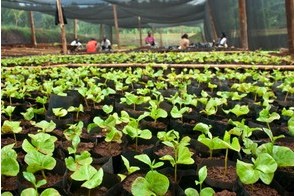Latest News
World Bank forecasts global poverty to fall below 10% for first time

News Highlight
- The World Bank Group's Board of Governors endorsed two goals in April 2013: to end extreme poverty by 2030, and boost shared prosperity.
- Sub-Saharan Africa accounts for half of the global poor, with some 12 percent living in East Asia.
There are indications that 25 years of sustained reduction in poverty is helping to move the world closer to the World Bank’s historic goal of ending poverty by 2030. According to a new report released by the World Bank of Sunday, the number of people living in extreme poverty is likely to fall to under 10 percent of the global population in 2015.
Jim Yong Kim, World Bank Group President, said that the major reductions in poverty were due to strong growth rates in developing countries in recent years, investments in people’s education, health, and social safety nets that helped keep people from falling back into poverty. Dr. Kim cautioned, however, that with slowing global economic growth, and with many of the world’s remaining poor people living in fragile and conflict-affected states, and the considerable depth and breadth of remaining poverty, the goal to end extreme poverty remained a highly ambitious target.
“This is the best story in the world today -- these projections show us that we are the first generation in human history that can end extreme poverty,’’ Kim said. “This new forecast of poverty falling into the single digits should give us new momentum and help us focus even more clearly on the most effective strategies to end extreme poverty. It will be extraordinarily hard, especially in a period of slower global growth, volatile financial markets, conflicts, high youth unemployment, and the growing impact of climate change. But it remains within our grasp, as long as our high aspirations are matched by country-led plans that help the still millions of people living in extreme poverty.”
In April 2013, nine months after Kim became president of the World Bank Group, its Board of Governors endorsed two goals: to end extreme poverty by 2030, and to boost shared prosperity by raising the incomes of the bottom 40 percent of populations.
Kim said that further reductions in poverty rates would come from evidence-based approaches, including broad-based growth that generates sufficient income-earning opportunities; investing in people’s development prospects through improving the coverage and quality of education, health, sanitation, and protecting the poor and vulnerable against sudden risks of unemployment, hunger, illness, drought and other calamities. These measures, he said, would also greatly boost shared prosperity and improve the welfare of the least well-off in every country.
“With these strategies in place, the world stands a vastly better chance of ending extreme poverty by 2030 and raising the life prospects of low-income families,” said Kim.
Sub-Saharan Africa accounts for half of the global poor, with some 12 percent living in East Asia. Poverty is declining in all regions but it is becoming deeper and more entrenched in countries that are either conflict ridden or overly dependent on commodity exports.
For the last several decades, East Asia and Pacific, South Asia, and Sub-Saharan Africa regions have accounted for some 95 percent of global poverty. Yet, the composition of poverty across these three regions has shifted dramatically. In 1990, East Asia accounted for half of the global poor, whereas some 15 percent lived in in Sub-Saharan Africa; by 2015 forecasts, this is almost exactly reversed.
The growing concentration of global poverty in Sub-Saharan Africa is of great concern. While some African countries have seen significant successes in reducing poverty, the region as a whole lags the rest of the world in the pace of lessening poverty. Sub-Saharan poverty fell from an estimated 56 percent in 1990 to a projected 35 percent in 2015. Rapid population growth remains a key factor blunting progress in many countries—as this year’s Global Monitoring Report to be launched on October 8 shows.
The World Bank uses an updated international poverty line of US $1.90 a day, which incorporates new information on differences in the cost of living across countries (the PPP exchange rates). The new line preserves the real purchasing power of the previous line (of $1.25 a day in 2005 prices) in the world’s poorest countries. Using this new line (as well as new country-level data on living standards), the World Bank projects that global poverty will have fallen from 902 million people or 12.8 per cent of the global population in 2012 to 702 million people, or 9.6 per cent of the global population, this year.
Related News
Latest Blogs
- Tackling antibiotic resistance through safer food systems
- Big government, little governance
- What will matter in Nigeria in 2026
- The Museum of West African Art saga
- The complexity and complication of Nigeria’s insecurity
Most Popular News
- NDIC pledges support towards financial system stability
- Artificial intelligence can help to reduce youth unemployment in Africa – ...
- Pan-African nonprofit appoints Newman as Advisory and Executive Boards Chair
- AfDB mobilises $11 billion for investment-led development
- World Bank approves $500m loan for small businesses in Nigeria
- UN adopts new consumer product safety principles







